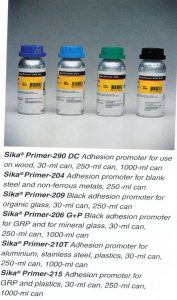Sikaflex comes in a variety of different forms for specialised purposes.. To bond materials two properties are essential in a marine environment – both materials must be adhered to and there must be no breakdown from water and UV radiation. Unfortunately Sika or no other product will bond a polycarbonate to alloy in an external environment subject to UV radiation. Sika 295UV comes close but preparation agents need to be applied and a UV protection strip also needs to be added. An important technique when using these type of products is to ensure that a bead of the sealant stays between the two surfaces. This means that fittings should NOT be tightened all the way down. Tightening should be done in a uniform fashion until the sealant starts to ooze out from the whole edge. Then stop and allow curing before final tightening or stressing.. Specialist advice would be useful before use. The following is a short summary of different Sikaflex products.
#..290DC – Polyurethane sealant most commonly used for caulking as it will withstand deck movement up to 10%
#..291 – Polyurethane sealant is a fast curing, sealing & bonding compound developed for manufacturing and repair applications. It has excellent adhesive properties and can be sanded and overpainted when cured.
#..298 – A bedding & bonding compound designed for use with large horizontal areas such as deck laying. Has and extended working period and spreads more easily and smoothly than 291.
#..292 – A high strength polyurethane based adhesive & sealing compound – used specifically for constructed applications such as bonding deck to hull, bedding in deck hardware such as hatches, chainplates, toe rails & all-through hull fittings.
#..295UV – A glazing sealant. It is a fast curing high performance adhesive, designed for bonding windows and portholes. It is suitable for use with all types of glass including polycarbonates.

Applications & Instructions
Marine Applications & Instructions
1. Levelling, Bonding and Caulking Teak Decks
2. Bonding Timber Components
3. Bonding Anti-Slip Deck Coverings
4. Bedding and Sealing of Fittings and Hardware
5. Flybridge Bonding
6. Bonding of Rub Rails and Fenders
7. Deck-to-Hull Bonding
8. Keel-to-Hull Joints
9. Bonding and Sealing Organic “Glass” Windows
10. Bonding and Sealing Mineral Glass Windows
11. Sealing of Sacrificial Anodes
12. Bonding of Decorative Panels and Work Surfaces
13. Bonding of Deck Panels and Feature Decks
14. Sealing of High-UV-Risk Areas
15. Bonding of Lightweight Internal Partitions
16. Bonding of Anti-Slip Plates for Engine Rooms
